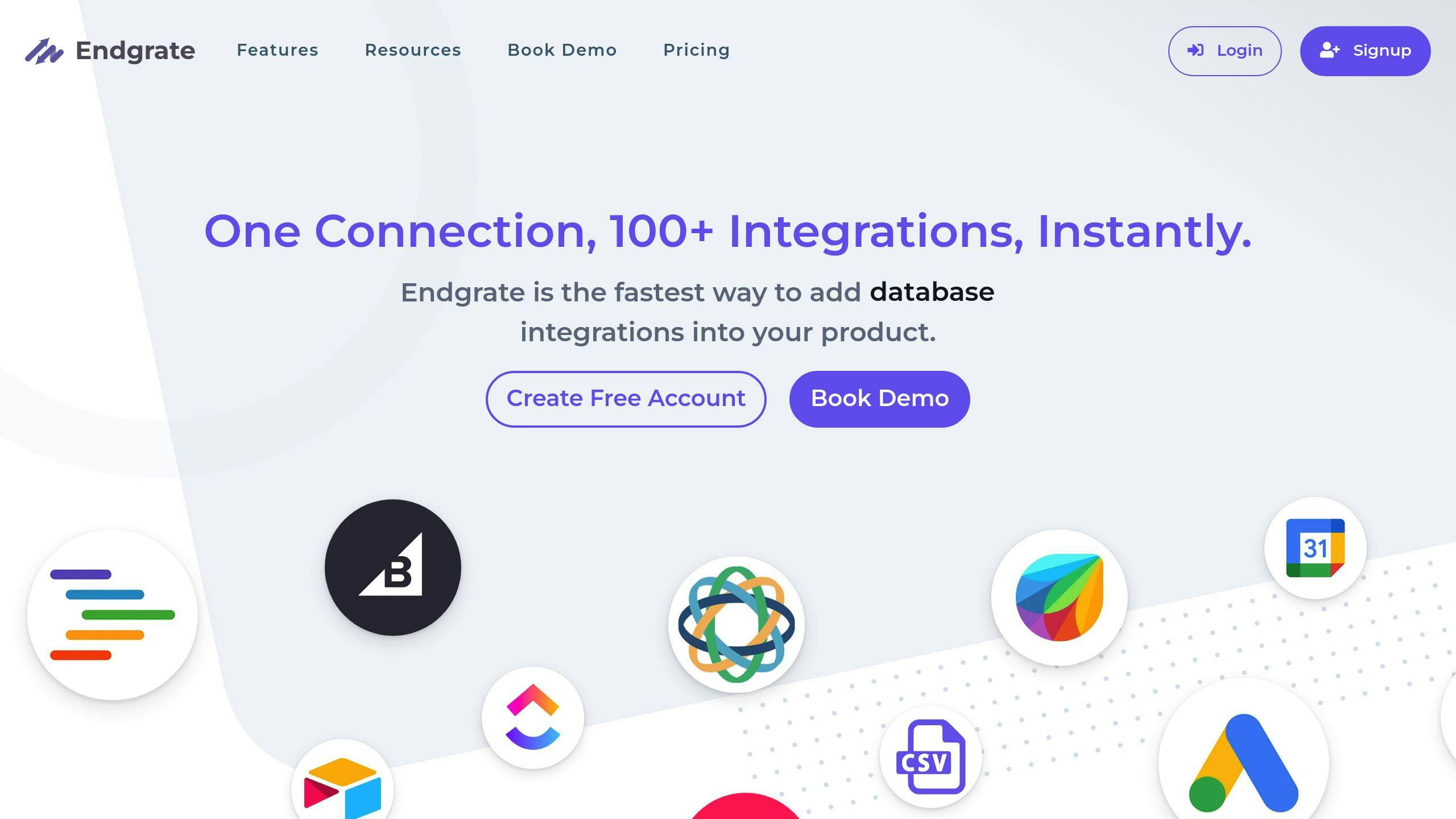Cross-Functional Collaboration with Virtual Tools

Cross-functional teams work across departments to achieve shared goals. With remote work on the rise, virtual tools like Zoom, Microsoft Teams, Slack, and Endgrate are essential for seamless collaboration. These tools enable quick communication, project tracking, knowledge sharing, and system integration.
Key Takeaways:
- Endgrate integrates 100+ tools via one API, simplifying workflows and reducing costs.
- Zoom is ideal for large video meetings (up to 1,000 participants).
- Microsoft Teams excels in document sharing and Office 365 integration.
- Slack is perfect for quick chats and app integrations but has limits on participants and message history.
Quick Comparison Table:
| Tool | Strengths | Limitations |
|---|---|---|
| Endgrate | Unified API, cost-efficient | Requires technical setup |
| Zoom | High-quality video, large groups | Limited collaboration features |
| Microsoft Teams | Office integration, document sharing | Complex interface |
| Slack | Simple messaging, app integrations | Participant and history limits |
For best results, mix tools based on team needs. For example:
- Enterprises: Microsoft Teams + Zoom + Endgrate.
- Startups: Slack + Zoom + Endgrate.
- Consulting Firms: Microsoft Teams + Zoom.
Related video from YouTube
1. Key Capabilities of Endgrate

Endgrate makes team collaboration simple with its all-in-one API approach. The platform connects more than 100 different tools, helping teams work better together - no matter which department they're in or what systems they use.
Integration Capabilities
The heart of Endgrate is its single API that brings all your business tools together. This means dev teams can stop juggling multiple connections and focus on what matters. Want to control how information flows between your tools? Endgrate lets teams set up custom data workflows that match exactly how they work.
Scalability and Flexibility
Need a solution that grows with you? Endgrate's got you covered. The platform offers:
- Full setup options to match your needs
- Deploy when you need it
- Top-notch security features
Cost Efficiency
Endgrate cuts down expenses across the board by putting all your integrations in one place. You'll spend less on:
- Development hours
- Team resources
- System upkeep
- Staff training
Plus, having everything under one roof makes daily operations much simpler.
Pro tip: While Endgrate handles your tool connections, pair it with platforms like Zoom or Microsoft Teams for real-time team chats and meetings. They work great together!
2. Common Features of Virtual Meeting Platforms (e.g., Zoom, Microsoft Teams, Slack)

Let's look at what makes today's virtual meeting platforms tick and how they help teams work together effectively.
Integration Capabilities
These platforms play nice with your other work tools. Microsoft Teams works perfectly with Office 365 apps - no surprise there. Slack? It connects with over 2,400 apps in its marketplace. And Zoom? It hooks right into your calendar apps to make scheduling a breeze.
Here's the thing: While Slack is pretty easy to pick up, Microsoft Teams might take some getting used to if you're not already familiar with Microsoft products. But once you're up and running, these tools make working together much easier.
Scalability and Flexibility
Need to grow? These platforms can handle it. Microsoft Teams works smoothly whether you've got 10 users or 100,000. And talk about handling growth - Zoom jumped from 10 million to 300 million daily users in 2020. That's what I call scaling up!
Collaboration Features
Each platform has its sweet spot. Microsoft Teams shines when you're working on documents together. Slack's the go-to for quick chats. And Zoom? It's the king of big video meetings.
| Feature | Zoom | Microsoft Teams | Slack |
|---|---|---|---|
| Video Conferencing | Up to 1000 participants | Up to 300 participants | Up to 50 participants |
| Screen Sharing | ✓ | ✓ | ✓ |
| Real-time Chat | ✓ | ✓ | ✓ |
Cost Efficiency
These tools won't break the bank. Zoom starts at $14.99 per user each month, while Teams comes as part of your Microsoft 365 subscription - pretty good deal if you're already using Microsoft's tools.
"Virtual collaboration has become a permanent cornerstone of modern teamwork", notes Jamie Davidson, Marketing Communications Manager for Vast Conference. This observation reflects the growing importance of selecting the right virtual meeting platform for your organization's specific needs.
sbb-itb-96038d7
Strengths and Weaknesses of the Tools
Let's break down what each virtual collaboration platform brings to the table for cross-functional teams. Microsoft Teams shines with Office integration and document sharing. Slack keeps things simple with quick messaging and tons of add-ons. Zoom? It's the go-to for video calls. And Endgrate ties everything together by connecting all your tools through one API.
| Tool | Key Strengths | Notable Limitations |
|---|---|---|
| Microsoft Teams | • Office 365 integration • Document collaboration • 300-participant meetings |
• Complex interface • High resource usage • Limited guest access |
| Slack | • Intuitive interface • Quick messaging • Extensive integrations |
• 50-participant limit • Message history caps • Channel overload |
| Zoom | • 1000-participant support • High video quality • Easy scheduling |
• Basic chat • Limited collaboration • Regional security issues |
| Endgrate | • Unified API management • Enterprise security • Resource optimization |
• Integration-focused • Technical setup • Limited communication |
Here's how these tools work in the real world:
Picture a global marketing team in action: They're jumping on Zoom to wow clients with presentations, using Teams to edit documents together, and letting Endgrate handle all their marketing automation behind the scenes. It's like having the best of each tool at their fingertips.
Different teams mix and match these tools to fit their needs. Software developers might pair up Endgrate and Slack to keep their DevOps running smoothly. Meanwhile, consulting firms often combine Zoom's crystal-clear video calls with Teams' document sharing to keep their client work on track.
Summary and Recommendations
The 44% surge in remote work over the past five years shows how picking the right mix of tools can make or break your business success. Let's break down what works best for different companies.
Big enterprise companies juggling complex projects? Microsoft Teams shines here. It works like a charm with Office 365 and handles medium-sized meetings without breaking a sweat.
For startups and small businesses, Slack's zippy communication style fits perfectly with fast-moving teams. Just keep in mind that 50-person limit - it might get tight as your team grows.
When it comes to client meetings, Zoom's still the king. With its top-notch video quality and ability to host huge meetings, it's perfect for events, training sessions, and big team gatherings.
Tech companies might want to check out Endgrate - their API connects over 100 tools, making life easier for tech-heavy workflows.
Here's a quick look at what works for different types of businesses:
| Business Type | Tool Mix | What You Get |
|---|---|---|
| Enterprise (500+ employees) | Teams + Zoom + Endgrate | Full document sharing, easier tool management |
| Small Businesses and Startups | Slack + Zoom/Endgrate | Quick chats, flexible meetings, smoother dev work |
| Consulting Firms | Teams + Zoom | Safe file sharing, polished client presentations |
Want to make these tools work even better? Set up clear plans using OKRs (Objectives and Key Results). This approach helps teams work together better by setting clear goals and keeping track of progress. It's especially good for teams working across different departments.
"The key to success lies not in choosing a single platform, but in strategically combining tools to meet specific business needs while maintaining clear collaboration frameworks."
Mix the right tools with smart teamwork strategies, and you'll see real results in how your team performs.
FAQs
What is the best platform to use for collaboration and sharing documents?
Picking the right platform boils down to what your team needs most - whether that's sharing files, chatting in real-time, or hosting big video calls. Here's what you need to know about the top tools:
| Platform | Best Use Cases | Key Strength |
|---|---|---|
| Microsoft Teams | Enterprise Teams | Works perfectly with Office 365 |
| Slack | Team Communication | Quick chats and easy file sharing |
| Zoom | Video Meetings | Crystal-clear video calls for up to 1000 people |
| Google Docs | Document Collaboration | Edit together in real-time |
| Asana | Project Management | Keep track of tasks across teams |
Here's the thing: Most teams get better results by mixing and matching tools instead of trying to find one that does it all. For example, you might use Slack for quick messages and Zoom when you need face-to-face time.
"Equipped with the right tools, cross-functional teams solve problems faster and more creatively."
Related posts
Ready to get started?
